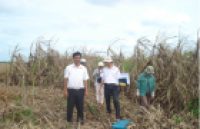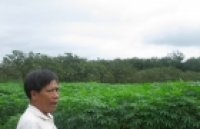| Transgene-free CRISPR/Cas9-mediated gene editing through protoplast-to-plant regeneration enhances active compounds in Salvia miltiorrhiza |
|
Salvia miltiorrhiza (red sage, Chinese pinyin; danshen) is used in Eastern medicine to treat cardiovascular diseases. S. miltiorrhiza contains water-soluble and lipid-soluble bioactive compounds, including phenolic acids and diterpenoid tanshinones, respectively (Shi et al., 2021); the latter gives its root surface a red colour (Skała and Wysokińska, 2005). |
|
Chen-Tran Hsu, Chi-Chou Chiu, Pao-Yuan Hsiao, Chih-Yu Lin, Sychyi Cheng, Yao-Cheng Lin, Yu-Liang Yang, Fu-Hui Wu, Horng-Jyh Harn, Shinn-Zong Lin, Choun-Sea Lin Plant Biotechnology Journal; First published: 04 January 2024; https://doi.org/10.1111/pbi.14285
Salvia miltiorrhiza (red sage, Chinese pinyin; danshen) is used in Eastern medicine to treat cardiovascular diseases. S. miltiorrhiza contains water-soluble and lipid-soluble bioactive compounds, including phenolic acids and diterpenoid tanshinones, respectively (Shi et al., 2021); the latter gives its root surface a red colour (Skała and Wysokińska, 2005). Several studies have sought to inactivate specific biosynthetic or transcription factor genes related to the bioactive compounds in S. miltiorrhiza by introducing a clustered regularly interspaced short palindromic repeat (CRISPR)-/CRISPR-associated nuclease 9 (Cas9)-based genome editing cassette via Agrobacterium-mediated hairy root transformation (Deng et al., 2020). Nevertheless, chimaeras in transformation and removing transgenes in plants with high-genetic heterozygosity like S. miltiorrhiza present significant challenges (Su et al., 2023). Here, we established a protoplast regeneration system for S. miltiorrhiza using either in vitro-assembled sgRNA-Cas9 ribonucleoprotein (RNP) complexes or plasmids carrying CRISPR/Cas9 system genes to target one or multiple sites for editing the genes through a single transfection event. As transcription factors regulating entire metabolic pathways are generally recognized as valuable tools for engineering elevated metabolite levels (Broun and Somerville, 2001), seven transcription factor genes—MYB28, MYB36, MYB39, MYB100, basic leucine zipper 1 (bZIP1), bZIP2 and MYB98—were selected as targets for mutagenesis. Of the 23 target sites selected (Table S1), three were previously reported for bZIP1, bZIP2 and MYB98 (Deng et al., 2020; Hao et al., 2020; Shi et al., 2021). We successfully established our S. miltiorrhiza protoplast regeneration system, which requires ~6 months from transfection of protoplasts to whole plants (Figure 1a; Data S1).
Figure 1: Regeneration of transgene-free gene-edited S. miltiorrhiza protoplasts into whole plants. (a) Establishment of a protoplast-to-plant regeneration system. Protoplasts were isolated from in vitro-grown plantlets through enzymatic leaf digestion; transgene-free CRISPR/Cas9 gene editing reagents were then introduced (Day 2). Alginate-Ca2+ gel with embedded protoplasts was incubated in a liquid medium in the dark (Week 3). Calli >5 mm were transferred to a fresh solid medium containing thidiazuron and incubated in light (Month 2). Multiple bud formation was observed in light (Month 3). Roots differentiated from calli with multiple buds in a phytohormone-free medium in light (Month 4). Plantlets transferred to pots (Month 6). (b, c) Editing efficiencies (number of validated regenerated gene-edited plants, in parentheses), as a percentage of total plants analysed, for individual target sites in bZIP1, bZIP2 and MYB98 transfected with plasmid (b) and in MYB36, MYB39, MYB28 and MYB100 transfected with RNP (c). Total, total plants analysed; T1–T5, target sites 1–5; edited, validated gene-edited plants; null, knockout plant confirmed by Sanger sequencing. (d, e) Characterization of 12 regenerated plants with MYB28 edited through transgene-free CRISPR-/Cas9-mediated mutagenesis. (d) Pre-validation of edited target sites 3 and 4 by cleavage with their respective RNP complexes in vitro. PCR-amplified MYB28 DNA fragments were incubated with RNP complex and then separated by electrophoresis. M, DNA size marker; WT, wildtype; +, −, WT genomic DNA incubated with and without RNP complex, respectively. White and black arrowheads indicate sizes of edited genomic DNA (cannot be cleaved by the RNP complex) and unedited genomic DNA after cleavage by the RNP complex, respectively. (e) RT-PCR analysis of MYB28 expression in six independent myb28 knockout plants. Actin served as a reference transcript. (f) Representative vegetatively propagated plant myb28#4-3 from stem cutting of myb28#4. (g) Genome editing of regenerated myb28 plants was stably inherited by their vegetatively propagated derivatives. (h) Phenotypes of 3-month-old wild-type and knockout mutants cultivated in the growth chamber. (i) Active compound contents in root extracts (mean ± SD; n = 4). Different letters signify statistically significant differences (P < 0.05). (j, k) Representative images of flowers from wild-type and null mutants (j) and white flowers of three clonally propagated plants from two independent regenerated knockout mutants of myb36 (#20, #62; k). |
|
|
|
[ Tin tức liên quan ]___________________________________________________
|


 Curently online :
Curently online :
 Total visitors :
Total visitors :
(223).png)


